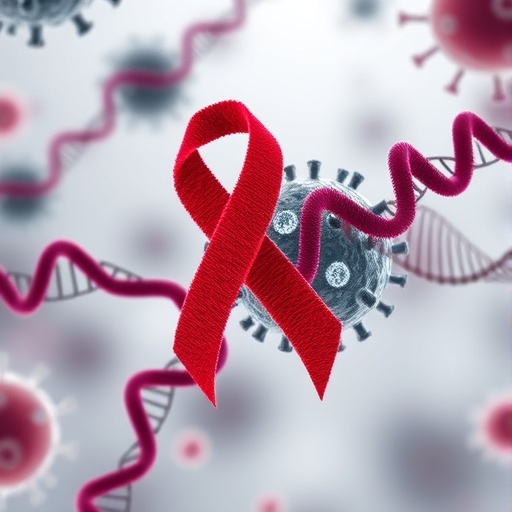A groundbreaking discovery from researchers at the German Center for Infection Research (DZIF) at Heidelberg University Hospital is poised to reshape our understanding of HIV-1’s integration into the human genome, unveiling a crucial vulnerability in the virus’s life cycle. Led by Dr. Marina Lusic and her team, this study reveals how HIV-1 exploits RNA:DNA hybrids, known as R-loops, to strategically select its integration sites, a mechanism previously unknown. Published in the prestigious journal Nature Microbiology, their findings open promising new avenues for therapeutic intervention targeting persistent HIV reservoirs that have thwarted curative treatments for decades.
HIV-1’s ability to establish lifelong infection hinges on its capacity to embed its genetic material into the DNA of host immune cells, particularly T cells, creating a permanent viral reservoir. The enzyme responsible for this integration, HIV-1 integrase, has long been recognized as a key player in viral persistence but until now, the molecular signals guiding its selection of integration sites remained elusive. Dr. Lusic’s team has illuminated this process by showing that these viral integrations are directed towards genomic regions rich in RNA:DNA hybrid structures, thereby resolving a long-standing mystery in retroviral biology.
RNA:DNA hybrids, or R-loops, arise during transcription when nascent RNA strands hybridize back with their DNA template strands, displacing the complementary DNA strand. These structures are notably prominent in non-coding regions of actively transcribed genes and have been implicated in various genomic regulatory processes and stability challenges. By mapping R-loops within human immune cells, the researchers elegantly demonstrated that HIV-1 integrase specifically targets these distinct nucleic acid configurations, effectively using them as molecular signposts to navigate the complex human genome.
Further molecular dissection revealed that the cellular enzyme Aquarius helicase (AQR) plays an indispensable role in facilitating the virus’s recognition and exploitation of R-loops. Aquarius, a splicing RNA helicase, binds directly to HIV-1 integrase, catalyzing the unwinding of R-loops and thereby promoting viral integration at these sites. The interaction between integrase and Aquarius represents a finely tuned mechanism by which HIV-1 co-opts host cell machinery to its advantage, underscoring the virus’s evolutionary adaptation to the cellular environment.
Experimentally, the team employed gene editing techniques to diminish levels of Aquarius within host cells and observed a striking result: the efficiency of HIV-1 integration plunged significantly, and the residual viral integration shifted towards regions poor in R-loops. This key observation not only validates Aquarius as a molecular facilitator of integration but also directly links R-loop density with viral integration preferences, offering a new layer of insight into host-virus dynamics.
The implications of these findings extend beyond molecular virology into the realm of therapeutic innovation. Current antiretroviral therapies effectively suppress viral replication but fail to eradicate latent reservoirs entrenched within the genome. The newly uncovered dependency on R-loops and Aquarius suggests potential strategies to disrupt HIV’s residency within these sanctuaries—either by targeting Aquarius’s helicase activity or by modulating R-loop formation—thereby undermining the virus’s capacity to maintain its hidden reservoirs.
Moreover, the strategic disruption of HIV-1’s integration pathway could herald a paradigm shift in HIV treatment, reducing or possibly eliminating the necessity for lifelong antiretroviral regimens. This would be especially critical given the growing global challenges in continuous drug provision, which increase risks of viral rebound and the emergence of drug-resistant strains. By obstructing the virus’s “molecular signposts,” future therapies could render HIV incapable of effectively embedding itself into host DNA, fundamentally limiting viral persistence.
This discovery emerges at a pivotal moment when global health systems grapple with instability affecting the uninterrupted delivery of HIV care. The novel insights on R-loop-mediated targeting introduce a much-needed avenue to counteract the consequences of treatment interruptions, potentially curbing the spread of resistant variants and improving patient prognosis worldwide.
The multidisciplinary nature of this research, incorporating expertise from bioinformatics, structural biology, and retrovirology, was vital to uncovering these complex interactions. Collaborative efforts spanned across European institutions in Zagreb, Padua, London, and Bordeaux, highlighting the international commitment to solving one of HIV’s most intractable challenges.
In summary, the identification of RNA:DNA hybrids as integration signposts and the critical involvement of Aquarius helicase represent a breakthrough in the fundamental understanding of HIV biology. This mechanism reveals a precise viral strategy that could be exploited to dismantle the resilient HIV reservoirs responsible for chronic infection, paving the way for next-generation antivirals that directly interrupt viral genome insertion.
Dr. Marina Lusic emphasizes the transformative potential of these findings: inhibiting the virus’s ability to recognize and utilize host RNA structures could revolutionize HIV therapy, offering hope for interventions that are not only more effective but also reduce dependency on lifelong drug administration. The quest for curative approaches to HIV infection thus gains a promising new molecular target.
As the scientific community continues to unravel the intricacies of HIV-host interplay, this study sets a precedent for targeting host-pathogen interfaces to control viral persistence. Future research will likely focus on characterizing small molecules or biological agents capable of interfering with Aquarius’s helicase function or modulating R-loop biology, enhancing our toolkit against HIV.
The profound insight into the molecular choreography of HIV integration into R-loop enriched regions exemplifies how basic science breakthroughs can catalyze innovative therapeutic strategies. In a field seeking to eradicate one of humanity’s most persistent viral foes, this discovery lights a new beacon on the path to lasting cures.
Subject of Research: Cells
Article Title: Aquarius helicase facilitates HIV-1 integration into R-loop enriched genomic regions
News Publication Date: 20-Aug-2025
Web References: 10.1038/s41564-025-02089-2
References: Published in Nature Microbiology
Keywords: HIV-1 integration, RNA:DNA hybrids, R-loops, Aquarius helicase, viral reservoirs, integrase enzyme, host-pathogen interaction, antiretroviral therapy, viral persistence, genome targeting, splicing enzyme, retrovirology




